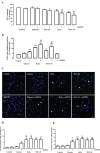Heme oxygenase-1 protects retinal endothelial cells against high glucose- and oxidative/nitrosative stress-induced toxicity
- PMID: 22879979
- PMCID: PMC3411771
- DOI: 10.1371/journal.pone.0042428
Heme oxygenase-1 protects retinal endothelial cells against high glucose- and oxidative/nitrosative stress-induced toxicity
Abstract
Diabetic retinopathy is a leading cause of visual loss and blindness, characterized by microvascular dysfunction. Hyperglycemia is considered the major pathogenic factor for the development of diabetic retinopathy and is associated with increased oxidative/nitrosative stress in the retina. Since heme oxygenase-1 (HO-1) is an enzyme with antioxidant and protective properties, we investigated the potential protective role of HO-1 in retinal endothelial cells exposed to high glucose and oxidative/nitrosative stress conditions. Retinal endothelial cells were exposed to elevated glucose, nitric oxide (NO) and hydrogen peroxide (H(2)O(2)). Cell viability and apoptosis were assessed by MTT assay, Hoechst staining, TUNEL assay and Annexin V labeling. The production of reactive oxygen species (ROS) was detected by the oxidation of 2',7'-dichlorodihydrofluorescein diacetate. The content of HO-1 was assessed by immunobloting and immunofluorescence. HO activity was determined by bilirubin production. Long-term exposure (7 days) of retinal endothelial cells to elevated glucose decreased cell viability and had no effect on HO-1 content. However, a short-time exposure (24 h) to elevated glucose did not alter cell viability, but increased both the levels of intracellular ROS and HO-1 content. Moreover, the inhibition of HO with SnPPIX unmasked the toxic effect of high glucose and revealed the protection conferred by HO-1. Oxidative/nitrosative stress conditions increased cell death and HO-1 protein levels. These effects of elevated glucose and HO inhibition on cell death were confirmed in primary endothelial cells (HUVECs). When cells were exposed to oxidative/nitrosative stress conditions there was also an increase in retinal endothelial cell death and HO-1 content. The inhibition of HO enhanced ROS production and the toxic effect induced by exposure to H(2)O(2) and NOC-18 (NO donor). Overexpression of HO-1 prevented the toxic effect induced by H(2)O(2) and NOC-18. In conclusion, HO-1 exerts a protective effect in retinal endothelial cells exposed to hyperglycemic and oxidative/nitrosative stress conditions.
Conflict of interest statement
Figures






Similar articles
-
High glucose and oxidative/nitrosative stress conditions induce apoptosis in retinal endothelial cells by a caspase-independent pathway.Exp Eye Res. 2009 May;88(5):983-91. doi: 10.1016/j.exer.2008.12.010. Epub 2009 Jan 3. Exp Eye Res. 2009. PMID: 19146853
-
Heme oxygenase-1-derived bilirubin protects endothelial cells against high glucose-induced damage.Free Radic Biol Med. 2015 Dec;89:91-8. doi: 10.1016/j.freeradbiomed.2015.07.151. Epub 2015 Sep 21. Free Radic Biol Med. 2015. PMID: 26391462
-
Curcumin protects retinal pigment epithelial cells against oxidative stress via induction of heme oxygenase-1 expression and reduction of reactive oxygen.Mol Vis. 2012;18:901-8. Epub 2012 Apr 11. Mol Vis. 2012. PMID: 22539869 Free PMC article.
-
HO-1: A new potential therapeutic target to combat osteoporosis.Eur J Pharmacol. 2021 Sep 5;906:174219. doi: 10.1016/j.ejphar.2021.174219. Epub 2021 May 31. Eur J Pharmacol. 2021. PMID: 34081904 Review.
-
Heme oxygenase in neonatal lung injury and repair.Antioxid Redox Signal. 2014 Nov 1;21(13):1881-92. doi: 10.1089/ars.2013.5791. Epub 2014 Feb 19. Antioxid Redox Signal. 2014. PMID: 24382006 Free PMC article. Review.
Cited by
-
The DPP4 Inhibitor Linagliptin Protects from Experimental Diabetic Retinopathy.PLoS One. 2016 Dec 12;11(12):e0167853. doi: 10.1371/journal.pone.0167853. eCollection 2016. PLoS One. 2016. PMID: 27942008 Free PMC article.
-
The roles of glucose metabolic reprogramming in chemo- and radio-resistance.J Exp Clin Cancer Res. 2019 May 23;38(1):218. doi: 10.1186/s13046-019-1214-z. J Exp Clin Cancer Res. 2019. PMID: 31122265 Free PMC article. Review.
-
Dimethyl Fumarate Triggers the Antioxidant Defense System in Human Retinal Endothelial Cells through Nrf2 Activation.Antioxidants (Basel). 2022 Sep 28;11(10):1924. doi: 10.3390/antiox11101924. Antioxidants (Basel). 2022. PMID: 36290650 Free PMC article.
-
Retinal endothelial cell apoptosis.Apoptosis. 2012 Dec;17(12):1258-60. doi: 10.1007/s10495-012-0777-3. Apoptosis. 2012. PMID: 23143137 Free PMC article. Review.
-
Biliverdin regulates NR2E3 and zebrafish retinal photoreceptor development.Sci Rep. 2022 May 4;12(1):7310. doi: 10.1038/s41598-022-11502-3. Sci Rep. 2022. PMID: 35508617 Free PMC article.
References
-
- Cunha-Vaz JG (2000) Diabetic retinopathy: surrogate outcomes for drug development for diabetic retinopathy. Ophthalmologica 214: 377–380. - PubMed
-
- DCCTResearchGroup (1995) The relationship of glycemic exposure (HbA1c) to the risk of development and progression of retinopathy in the diabetes control and complications trial. Diabetes 44: 968–983. - PubMed
-
- Nakamura M, Barber AJ, Antonetti DA, LaNoue KF, Robinson KA, et al. (2001) Excessive hexosamines block the neuroprotective effect of insulin and induce apoptosis in retinal neurons. J Biol Chem 276: 43748–43755. - PubMed
-
- Williamson JR, Chang K, Frangos M, Hasan KS, Ido Y, et al. (1993) Hyperglycemic pseudohypoxia and diabetic complications. Diabetes 42: 801–813. - PubMed
Publication types
MeSH terms
Substances
LinkOut - more resources
Full Text Sources

